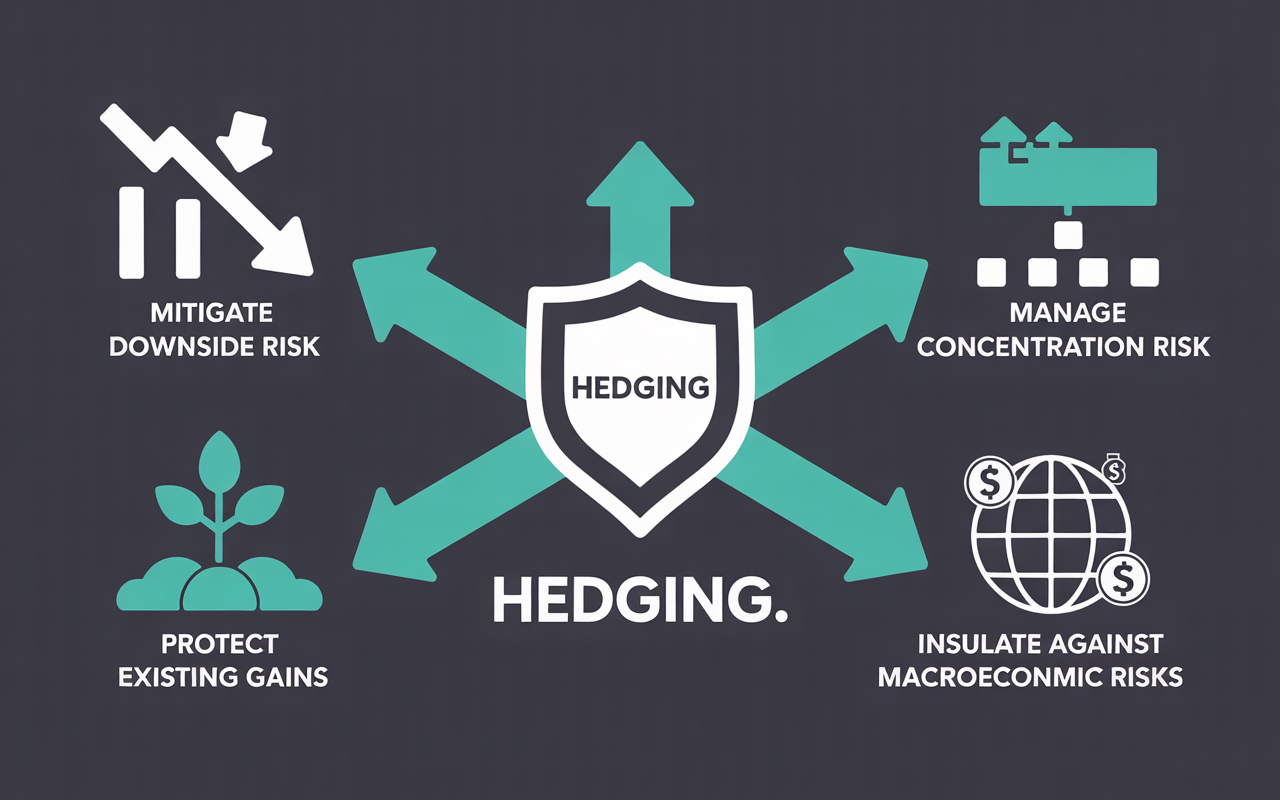The world of investing is a thrilling landscape of opportunity and growth, but it is also one of inherent uncertainty. Market fluctuations, economic shifts, and unforeseen global events can cause the value of even the most promising assets to decline. For any investor, from a seasoned professional to a curious beginner, navigating this volatility is the key to long-term success.
This leads to one of the most fundamental questions in risk management: what is the purpose of hedging as an investment strategy? This question is not about chasing higher returns; it’s about building a fortress around the returns you already have. Answering what is the purpose of hedging as an investment strategy is the first step toward becoming a more resilient investor.
This comprehensive guide is dedicated to providing a clear, in-depth, and practical answer to that very question. We will demystify the concept of hedging, explore the tools and techniques used to implement it, and analyze the core reasons why investors choose to protect their portfolios from downside risk. Understanding what is the purpose of hedging as an investment strategy is about shifting your mindset from purely focusing on gains to intelligently managing potential losses, a discipline that can mean the difference between anxiety and peace of mind.
Defining the Core Concept: A Financial Safety Net
At its heart, hedging is a risk management technique designed to reduce or offset the risk of adverse price movements in an asset. The simplest way to understand it is to think of it as a form of insurance. When you buy home insurance, you are hedging against the financial devastation of a fire or a flood. You pay a small, regular fee (the premium) to protect yourself from a large, uncertain loss. You hope you never have to use the policy, but it provides security.
In the financial world, hedging works in much the same way. An investor will make a second investment that is intentionally designed to move in the opposite direction of their primary investment. If the primary investment goes down in value, the hedge is designed to go up, offsetting some or all of the loss. This is the foundational principle behind the entire concept. The complete answer to what is the purpose of hedging as an investment strategy lies in this idea of creating a financial safety net.
It is crucial to understand that hedging is not a strategy for making money. It is a strategy for not losing money. This distinction is paramount. By its very nature, a successful hedge will also limit your potential profits if your primary investment performs well. Just as you don’t get your home insurance premiums back if your house doesn’t burn down, the cost of a hedge is the price you pay for protection.

Common Tools and Techniques for Hedging
Investors have a variety of tools at their disposal to implement a hedging strategy. The specific tool used depends on the asset being hedged and the investor’s goals. Knowing these tools is part of knowing what is the purpose of hedging as an investment strategy. The table below summarizes some of the most common methods.
| Hedging Tool/Technique | Description | Typical Use Case |
|---|---|---|
| Options (Put Options) | A contract giving the right to sell an asset at a set price. Acts like direct insurance on a specific stock holding. | An investor wants to protect a large stock position from a short-term decline without selling the shares. |
| Futures Contracts | An agreement to buy or sell an asset at a predetermined future price. Locks in a price to eliminate uncertainty. | A farmer hedges against falling crop prices; an airline hedges against rising fuel prices. |
| Diversification | Spreading investments across various non-correlated assets, sectors, and geographies. | The foundational strategy for all long-term investors to reduce overall portfolio volatility. |
| Short Selling | Selling a borrowed security with the hope of buying it back at a lower price. | An advanced investor shorts a market index ETF to hedge a large portfolio of individual stocks against a market-wide downturn. |
| Inverse ETFs | Exchange-Traded Funds designed to move in the opposite direction of a benchmark index (e.g., the S&P 500). | An investor buys an inverse S&P 500 ETF to protect their broad stock market portfolio from a bear market. |
Each of these tools helps to answer the question, what is the purpose of hedging as an investment strategy?, in a different way.

What is the Purpose of Hedging as an Investment Strategy: Key Goals
We’ve established that the overarching purpose is risk management, but we can break this down into several specific goals. This section provides a detailed answer to the question, what is the purpose of hedging as an investment strategy?
To Mitigate Downside Risk
This is the primary and most obvious goal. Every investment carries the risk of loss. Hedging aims to put a floor on those potential losses. By taking an offsetting position, an investor can ensure that a catastrophic drop in one asset’s value does not wipe out their portfolio. This protective element is the core of what is the purpose of hedging as an investment strategy. Anyone asking what is the purpose of hedging as an investment strategy should first understand this core principle of loss mitigation.
To Protect Existing Gains
Imagine you have a stock that has appreciated significantly. You believe it has more room to grow, but you’re also worried about a potential pullback that could erase your profits. Instead of selling the stock and creating a taxable event, you could use a hedge (like buying a put option) to protect a large portion of your gains while still holding the stock to capture further upside. This shows that what is the purpose of hedging as an investment strategy can be about protecting profits, not just preventing initial losses.
To Manage Concentration Risk
This is particularly relevant for individuals who have a large portion of their net worth tied up in a single stock, often from their employer. This high concentration is very risky. An employee in this situation might use hedging strategies to protect the value of their holdings without having to sell the stock, which might be restricted or have significant tax implications. In this case, what is the purpose of hedging as an an investment strategy is to diversify risk without diversifying ownership.
To Insulate Against Macroeconomic Risks
Hedging can be used to protect against broad market risks that affect many assets at once.
- Currency Risk: If you are a U.S. investor who owns European stocks, your returns are affected by both the stock performance and the EUR/USD exchange rate. You can use currency forwards or options to hedge against the risk of the euro weakening against the dollar.
- Interest Rate Risk: Bond prices fall when interest rates rise. An investor with a large bond portfolio might use interest rate swaps or options to hedge against the risk of rising rates.
Understanding what is the purpose of hedging as an investment strategy includes appreciating its role in managing these large-scale risks. Knowing what is the purpose of hedging as an investment strategy helps in navigating global markets.
To Provide Business and Budgetary Certainty
As mentioned with the airline example, many corporations hedge as a normal part of their business operations. A food company might hedge the cost of wheat, a construction company might hedge the cost of steel, and a multinational corporation might hedge its foreign currency revenues. For these entities, what is the purpose of hedging as an investment strategy is to create predictable costs and revenues, which allows for more accurate budgeting and financial planning. Their answer to what is the purpose of hedging as an investment strategy is operational stability.

The Inherent Trade-Off: The Cost of Hedging
Hedging is not a free lunch. The reduction in risk always comes at a cost, either direct or indirect. This trade-off is fundamental to understanding what is the purpose of hedging as an investment strategy.
Direct Costs
This is the most obvious cost. When you buy an option to hedge a position, you must pay a premium. That premium is a direct, out-of-pocket expense. If the negative event you are hedging against never happens, that premium is lost.
Opportunity Costs (Capped Gains)
This is the more subtle but equally important cost. A successful hedge that protects you from a loss will also reduce your potential profit if the asset appreciates. Let’s go back to the investor with XYZ Corp at $50. If the stock soars to $70, their put option at $45 expires worthless, and their total profit is slightly reduced by the premium they paid for that protection. By limiting the downside, you are almost always limiting the upside. Acknowledging this is crucial to understanding what is the purpose of hedging as an investment strategy.

Frequently Asked Questions (FAQs)
Q: What is the purpose of hedging as an investment strategy, in simple terms?
A: In simple terms, it’s like buying insurance for your investments. The main goal is to protect your portfolio from large losses, not to make a profit.
Q: Is diversification a form of hedging?
A: Yes, diversification is the most fundamental and accessible form of hedging for most individual investors. By spreading your money across different asset classes, you reduce the risk that a downturn in one area will severely impact your entire portfolio.
Q: Can hedging eliminate all risk?
A: No, hedging can only reduce or manage risk; it cannot eliminate it entirely. There is always a cost involved, and no hedge is perfect. The goal is to make potential losses more manageable.
Q: Is hedging only for professional traders?
A: Complex hedging strategies using derivatives like options and futures are typically best left to sophisticated investors. However, the core principle of hedging, primarily through diversification, is a crucial concept for all investors to understand and apply. For most people, the answer to what is the purpose of hedging as an investment strategy is best realized through diversification.
Q: If hedging limits my potential profits, why should I do it?
A: The decision to hedge depends on your risk tolerance. If your primary goal is capital preservation and avoiding large drawdowns, the cost of limiting your upside can be a worthwhile price to pay for peace of mind. The real answer to what is the purpose of hedging as an investment strategy is about sleeping well at night.
Q: What is a “perfect hedge”?
A: A perfect hedge is a theoretical position that completely eliminates all risk from a position. In the real world, perfect hedges are extremely rare and often impractical or too expensive to implement.
Final Thoughts: A Tool for Prudence, Not Profit

We return to our central question: what is the purpose of hedging as an investment strategy? The clearest answer is that it is a strategy of prudence. It is the act of preparing for financial storms during calm weather. It is the acknowledgment that preserving capital is just as important, if not more so, than generating spectacular returns.
For most long-term, individual investors, a well-diversified portfolio of low-cost funds is the most effective and practical hedge. The more complex strategies involving derivatives are typically the domain of sophisticated investors, corporations, and large investment funds. However, understanding the principles behind them can make anyone a more informed and resilient investor. If you only remember one thing, remember that diversification is the best answer to what is the purpose of hedging as an investment strategy for you.
Ultimately, knowing what is the purpose of hedging as an investment strategy is about recognizing that you have tools to protect yourself from the market’s inherent volatility. It’s about shifting the focus from a one-dimensional pursuit of gain to a two-dimensional strategy of managing both risk and reward.
By embracing this mindset, you can navigate your investment journey with greater confidence, prepared for whatever the market may bring. The true value in understanding what is the purpose of hedging as an investment strategy is the peace of mind that comes from knowing you have a plan for the worst-case scenario. When you understand what is the purpose of hedging as an investment strategy, you understand the importance of financial defense.